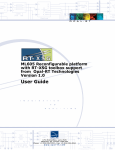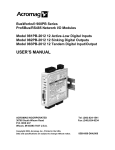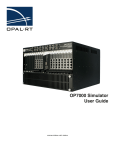Download OP5251 USER GUIDE - Opal-RT
Transcript
OP5251 USER GUIDE Optically Isolated 32 Digital Inputs & 32 Digital Outputs Module www.opal-rt.com Published by Opal-RT Technologies, Inc. 1751 Richardson, suite 2525 Montréal (Québec) Canada H3K 1G6 www.opal-rt.com © 2010 Opal-RT Technologies, Inc. All rights reserved Printed in Canada CONTENTS GETTING STARTED................................................................................................................................. 4 SOFTWARE REQUIREMENTS............................................................................................................. 4 HARDWARE REQUIREMENTS............................................................................................................ 4 FEATURES............................................................................................................................................ 4 MODULE INSTALLATION . ................................................................................................................... 4 INTRODUCTION ...................................................................................................................................... 5 DESCRIPTION ..................................................................................................................................... 5 CIRCUIT LAYOUT DIAGRAMS.............................................................................................................. 5 RS-422 Communication Module...........................................................................................................................6 INTERFACES................................................................................................................................................................... 6 Inputs............................................................................................................................................................................... 6 Outputs............................................................................................................................................................................. 8 Interconnections.................................................................................................................................................8 VUSER POWER CONFIGURATION . ...................................................................................................... 9 VOLTAGE RANGE SELECTION . ......................................................................................................................9 PIN ASSIGNMENTS . ......................................................................................................................... 11 ...................................................................................................................................................................................... 11 SPECIFICATIONS . ................................................................................................................................ 12 ACCESSORIES................................................................................................................................... 13 126-0274: Female 96DIN screw terminal. .........................................................................................................13 26-0292: 64 D I/O DIN96 4 x 50 adapter. .........................................................................................................14 113-0374L 2 x 50-pins IDC50 cable..................................................................................................................14 3 OP5251 User Manual — Opal-RT Technologies GETTING STARTED MODULE INSTALLATION GETTING STARTED Before you begin, verify that your system meets the requirements of the OP5251 I/O board: SOFTWARE REQUIREMENTS • • • • RT-LAB 8.4.0 and higher MATLAB 32 bits 6.5 and higher Windows XP and higher RT-XSG 1.3 HARDWARE REQUIREMENTS • Opal-RT simulator: -- Wanda box -- Opal-RT I/O expansion box (only for use with Opal-RT simulators) FEATURES • 32 optically isolated input channels • 32 optically isolated output channels • All I/Os are sampled simultaneously for additional simulation accuracy. They can be sampled up to 5 MHz • I/Os can be grouped in parallel for any size bus simulation • User configurable filters, de-bounce time and conditioning inputs • Choice of sink or source inputs (Factory Options for Common Anode or Common cathode) • All inputs accept sources from 4V to 30V and limit the current via user interchangeable resistors on sockets grouped in 4 input or 8 output channels. MODULE INSTALLATION The OP5251 Digital Input Signal Conditioning Module must be inserted into the Opal-RT simulator using great care. Make sure that the card is properly aligned, using the guide tracks, before pressing into place. OP5251 User Manual — Opal-RT Technologies 4 INTRODUCTION Circuit Layout Diagrams INTRODUCTION The OP5251 is a part of the OP5000 series of optional, versatile signal conditioning modules for OpalRT’s state of the art HIL (hardware-in-the-loop) systems. Designed for Opal-RT’s simulation systems, the OP5251 provides digital input and output signals with specific voltage conditioning. The optical isolation of the OP5251 I/Os make it ideal for environments where voltage isolation is required. DESCRIPTION The OP5251 features 32 optically isolated input channels and 32 optically isolated output channels. All of these I/Os are sampled simultaneously for additional simulation accuracy. It is perfectly suited to interface real life environment signals to TTL or Differential for RT-LAB simulator, providing perfect electrical isolation and full short-circuit or discharge protection. CIRCUIT LAYOUT DIAGRAMS COMPONENT FREE AREA - DO NOT REMOVE R104 C40 C30 R93 R122 R121 R96 R95 R124 R123 R150 R149 R178 R177 R152 R151 R180 R179 U16 C70 R207 R236 R235 U19 F2 R254 U17 C82 C81 R261 U27 R258 C89 R270 C90 R278 C92 U25 R9 R13 R314 R315 U57 +5V_Int R21 R17 R326 D69 R285 R286 C98 R294 C100 C128 C97 R268 C99 +12V_Int U33 R281 U35 R274 R5 Place fiber spacer here for DC-DC Converter through-hole package R1 R328 R6 +3V3_Int +5V_Iso D68 D66 C129 U50 C119 R317 C74 D32 R265 R277 J2 R18 D67 R266 R249 R22 R20 R24 R23 R19 U49 R282 F1 C123 R7 R3 R4 R8 R14 R10 U54 C80 RN8 R238 R269 R250 C79 R216 D28 D30 R208 R318 R240 D31 C66 R233 C118 R248 R246 R205 R234 R325 R230 R232 R15 R11 R12 R16 C115 C116 C117C113 R200 C64 R198 R214 C68 C72 R226 R222 R224 C62 R228 R212 R210 R242 C76 C71 R253 C78 C73 R237 D24 U14 R244 R215 C77 R197 R227 C69 U15 RN7 R220 R218 C122 U53 D26 D27 D29 R243 R247 R245 R239 C54 C65 R196 R202 R204 U56 C121 U52 D16 R194 R225 R221 R223 R229 R231 RN6 R199 C67 D20 D22 C60 C52 R213 R160 R170 R211 R209 C50 U12 R182 D23 C46 C56 R192 R190 R184 R219 R217 C61 U13 C63 C59 R144 R142 C44 C48 R158 R172 C53 R181 C42 U10 R241 C75 RN5 R168 R174 R176 R67 R94 R206 R188 R159 C49 U11 R166 R68 R2 RN4 C34 R126 D25 R193 R195 R201 R203 J1 U55 C125 R327 D15 D18 R186 C55 R185 C58 C51 R169 R191 R189 R183 R154 D19 D21 R171 R173 R175 R164 R162 R156 C45 R187 R165 R167 C57 R141 R143 R157 C47 R155 R153 C41 U9 C43 R147 R163 R161 R140 R146 R148 R39 C120 R313 C39 R88 C24 R86 C28 R102 R116 U8 C32 R114 R136 R134 R128 C26 D12 D14 S/N R138 D17 R137 R139 R145 R40 U51 C114 RN3 R125 Made in Canada R65 C124 R132 C38 R115 D8 C33 R110 R112 R118 R120 R130 C36 RN2 C37 R87 R103 C23 C27 R101 R133 R127 C14 C29 U7 C22 U6 D11 D13 C35 R135 R26 C25 R84 R90 R92 R108 R106 R100 R98 C31 R113 C20 U4 R37 R66 R319 R70 R85 C19 R32 R48 R60 R58 C12 R72 R75 C10 R109 R111 R117 R119 R129 D7 R99 R97 C6 D10 R82 C21 U5 D6 C16 R80 R78 R74 RN1 R54 R56 R62 R64 R107 R105 D4 R76 C18 C9 C13 R69 R46 R47 C11 U3 C15 R61 R63 R79 RN14 R77 R71 R73 RN13 C8 C7 R44 R42 D5 R53 R55 R83 R89 R91 U2 R38 R316 D9 R81 C2 R50 C5 D3 R59 R57 R41 J3 R36 R52 R45 R49 R43 Vuser_DIN R28 R34 R30 C1 U1 R51 C4 D2 C17 R29 R35 R31 R25 R27 R33 C3 D70 D1 R131 D65 OPAL-RT Technologies Inc. 2009 Opto-Isolated Digital Board - 32 Din/Dout E06-0229 Rev 1.1 R293 R290 C83 F5 R262 C84 R255 C91 R252 U29 R273 R271 U39 U37 R289 R287 R301 R298 R284 F6 RN15 U43 RN9 F7 U20 RN10 U18 R251 R256 C85 F8 C86 R263 U28 R272 C93 R260 C94 U26 R267 R279 RN11 R276 U34 R283 U36 C101 C102 R288 R295 C105 R302 C106 C87 PWR1 D33 D34 F9 U24 R264 F10 C88 U22 R259 C95 U30 R275 U32 F17 R280 F18 C96 U40 C103 C104 R296 U38 R291 F25 F26 F11 F12 F19 F20 F27 F28 F13 F14 F21 F22 F29 F30 F15 F16 F23 F24 F31 F32 OPAL-RT U41 R297 R309 R306 R292 U47 Vuser_DOUT C127 U31 U21 R257 U23 F4 C126 F3 C107 RN12 U45 R305 R310 C108 R304 C110 R311 R312 C112 U44 C109 U48 C111 R303 R300 R299 U42 R308 U46 R307 COMPONENT FREE AREA - DO NOT REMOVE Figure 1: OP5251 Digital Signal Conditioning Module 5 OP5251 User Manual — Opal-RT Technologies INTRODUCTION Circuit Layout Diagrams RS-422 Communication Module The communication module is offered as an option to convert the first 8 inputs and 8 outputs to differential I/Os, using an RS-422 cable. The board is easily inserted onto the OP5251, over the connectors RN13, RN14, RN15, RN1, RN2, RN9 and PWR1. Consult the “Pin Assignments” table for details on pin connections and channels for the RS-422 cable. Figure 2: RS-422 Communication Module PCB Diagram ! CAUTION Do not bend the pins when inserting or removing the RS-422 Communication Module into the OP5251. INTERFACES Inputs The optically isolated inputs accept a wide range of input voltage, ranging from 4 to 30 Volts, according to user’s requirements. They have a low threshold current; typically 6 mA within the 5 to 15 mA range. The inputs are current limited by the interchangeable resistor array mounted on sockets. The resistor value may be changed by the user to enable higher input voltage. By default, the module comes equipped with the resistor value set to 680 Ohms, which is recommended for 5 to 12 Volts input. Each input has a reverse voltage protection of 5 Volts or more provided by a diode. Digital Input Isolated User +V VUser (5 to 30V) TO FPGA R 1 2 OPTIONAL FILTER Din Vuser RTN 1 2 OPTION1: COMMON ANODE OPTION 2: COMMON CATHODE MODE SELECTION WITH ON-BOARD ZERO-OHM RESISTORS Figure 3: OP5251 Isolated Digital Input Drawing OP5251 User Manual — Opal-RT Technologies 6 INTRODUCTION Circuit Layout Diagrams The signal conditioning module inputs can be factory ordered to either common anode (default setting) or common cathode. R Vuser 5 - 15 mA Din I Din OPTION 1: COMMON ANODE R 5 - 15 mA Vuser_ RTN I OPTION 2: COMMON CATHODE Figure 4: Common Anode (Push) mode and Common Cathode (Pull) mode Each digital input channel is a positive logic circuit; a high input signal produces a high input state at the host data acquisition board. The source voltage (Vuser*) serves as the reference for the positive voltage level (see Voltage Range Selection). * Vuser = 4 to 30 V+; Vuser RTN = 0 to -30 V Note that if the input is mounted in common cathode mode then the channel becomes a negative logic circuit 7 OP5251 User Manual — Opal-RT Technologies INTRODUCTION Circuit Layout Diagrams Outputs Each optically isolated output has an open collector transistor. It can sink up to 100 mA continuous, and up to +30V according to user’s requirements. It is current protected by resettable 150 mA fuse (PTC). The onboard optical isolation circuitry requires an external power feed (Vuser). ! CAUTION: If Vuser is connected to the simulator, the output of DOUT would be the same as Vuser Dout as long as no RT-LAB model is running (output transistor is open). Digital Output Isolated Vuser Dout resettable fuse RL +V_ISO +V 100 mA continuous maximum Vuser_ RTN Interconnections TO FPGA Figure 5: Isolated Digital Output Drawing (Pull only) The OP5251 is a carrierless module. It fits directly into the OP5000 series of hardware-in-the-Loop simulators without carriers. Up to four OP5251 can be positioned in a Wanda3U / 4U and up to 8 in an OPAL-RT Expansion Box. OP5251 User Manual — Opal-RT Technologies 8 VUSER Power Configuration Circuit Layout Diagrams VUSER POWER CONFIGURATION The digital input circuit needs a 5 V supply source to power the onboard circuitry. This source is connected to the computer’s 5 VDC. The digital outputs use an isolated DC-DC converter to power onboard circuitry. The following resistors are used for the OP5251: Digital Input Digital Output Voltage range (Volts - continuous) Resistor value (Ω) Resistor Network Bourns Part Number 4-9 470 4608X-102-471 LF / 4308X-102-471 LF 5-12 680 (default) 4608X-102-681LF / 4308X-102-681 LF 6-16 1000 4608X-102-102 LF / 4308X-102-102 LF 12-30 2200 4608H-102-222 LF / 4308H-102-222 LF 0-8 270 4609H-101-271 LF / 4309H-101-271 LF 0-15 1000 (default) 4609H-101-102 LF / 4309H-101-102 LF 0-30 4700 4609H-101-472 LF / 4309H-101-472 LF Table 1: Digital Input/Output Voltage and Resistor Values ! WARNING: ensure that proper resistor network is installed to obtain desired operating voltage. Failure to do so may result in damage to OP5251 board or host setup. VOLTAGE RANGE SELECTION Inputs: Changing the value of resistor network RN1 to RN8 will configure the digital input voltage range in groups of 4. Using a DIP-8 isolated resistor network, make sure you match the pin 1 indicator with pin 1 on the module. If needed, you can add an additional resistor in series with the input circuit to increase the supply voltage. = Pin 1 4608X-102-222 LF User Vcc TC4049/4050 R1 Opal-RT Din R254 R249 U17 C82 R261 U27 R258 C89 R270 C90 R278 C92 U25 R265 R277 C98 C100 R6 R5 here for DC-DC Converter through-hole package D68 D69 R285 R286 R294 +12V_Int U33 R281 U35 C97 R274 R2 R328 R266 R282 U19 C81 R1 R269 R250 F1 F2 R327 R253 R3 R3 RN10 R293 R290 C83 F5 U31 U21 R257 U23 R262 C84 R255 C91 R252 U29 R273 R271 U39 R268 C99 U37 R289 R287 R301 R298 R284 F6 RN15 U43 RN9 F7 U20 U18 R251 R256 C85 F8 C86 R263 RN10 U28 R272 C93 R260 C94 U26 R267 R279 RN11 R276 U34 R283 U36 C101 C102 R288 R295 C87 R264 F10 C88 U22 R259 C95 U30 R275 U32 C96 U40 C105 R302 C106 C104 R296 U38 R291 F17 R280 F18 F25 F26 F11 F12 F19 F20 F27 F28 F13 F14 F21 F22 F29 F30 F15 F16 F23 F24 F31 F32 F9 C103 OPAL-RT U41 R297 R309 R306 R292 U47 U24 C127 F4 C126 F3 PWR1 Outputs: Changing the value of resistor network RN9 to RN12 will configure the output voltage range in groups of 8. Using a DIP-9 isolated resistor network, make sure you match the pin 1 indicator with pin 1 on the module. If needed, you can add an additional resistor in series with the input circuit to increase the supply voltage. INTERFACE BETWEEN CMOS DRIVE AND Opal-RT Din C107 RN12 U45 R305 R310 C108 R304 C110 R311 R312 C112 U44 C109 U48 C111 R303 R300 R299 U42 R308 U46 R307 COMPONENT FREE AREA - DO NOT REMOVE 5V 6 mA Figure 6: Digital input circuit 9 OP5251 User Manual — Opal-RT Technologies VUSER Power Configuration Circuit Layout Diagrams Each input resistor network contains 4 digital input channels. Refer to the “Resistor Network” table below for the relationship between the resistor network and input channels. To work properly, the OpalRT digital input optical isolator needs a minimum current of 5 mA and a maximum current of 15 mA. Use the following formula to ensure safe power: (Vuser -1.5 [V]/resistor (Ω) = current (A) Resistor network Channel bank RN1 Din 00-03 RN2 Din 04-07 RN3 Din 08-11 RN4 Din 12-15 RN5 Din 16-19 RN6 Din 20-23 RN7 Din 24-27 RN8 Din 28-31 Table 2: Din Resistor Network by Channel Bank Each output resistor network contains 8 digital input channels. Refer to the Resistor Network table below for the relationship between the resistor network and inputs channels. Use the following formula to ensure safe power: Vuser (V)/resistor (Ω) = current (A). Resistor network Channel bank RN9 Dout 00-07 RN10 Dout 08-15 RN11 Dout 16-23 RN12 Dout 24-31 Table 3: Dout Resistor Network by Channel Bank All digital I/Os are accessible via a 96 pin, 3 x 32, DIN96 connector (part number 5650461-5 or 5650462-5). Pay careful attention to the position diagram and Pin Assignment table to ensure proper and safe function. A32 A1 B32 B1 C32 C1 Figure 7: DIN96 Pin Assignment (female connector view) OP5251 User Manual — Opal-RT Technologies 10 VUSER Power Configuration Pin Assignments PIN ASSIGNMENTS Screw 1260262 A32 B32 C32 A31 B31 C31 A30 B30 C30 A29 B29 C29 A28 B28 C28 A27 B27 C27 A26 B26 C26 A25 B25 C25 A24 B24 C24 A23 B23 C23 A22 B22 C22 A21 B21 C21 A20 B20 C20 A19 B19 C19 A18 B18 C18 A17 B17 C17 11 Screw 126-0075 Section A 1 2 3 4 5 6 7 8 9 10 11 12 13 14 15 16 17 18 19 20 21 22 23 24 25 26 27 28 29 30 31 32 33 34 35 36 37 38 39 40 41 42 43 44 45 46 47 48 Module pin assignment RS422_IN_CH0RS422_IN_CH1RS422_IN_CH2RS422_IN_CH3RS422_IN_CH4RS422_IN_CH5RS422_IN_CH6RS422_IN_CH7RS422_OUT_CH0RS422_OUT_CH1RS422_OUT_CH2RS422_OUT_CH3RS422_OUT_CH4RS422_OUT_CH5Vuser-DIN Vuser-DIN IN 00 / RS422_IN_CH0+ IN 01 / RS422_IN_CH1+ IN 02 / RS422_IN_CH2+ IN 03 / RS422_IN_CH3+ IN 04 / RS422_IN_CH4+ IN 05 / RS422_IN_CH5+ IN 06 / RS422_IN_CH6+ IN 07 / RS422_IN_CH7+ IN 08 IN 09 IN 10 IN 11 IN 12 IN 13 IN 14 IN 15 IN 16 IN 17 IN 18 IN 19 IN 20 IN 21 IN 22 IN 23 IN 24 IN 25 IN 26 IN 27 IN 28 IN 29 IN 30 IN 31 Screw 1260262 A16 B16 C16 A15 B15 C15 A14 B14 C14 A13 B13 C13 A12 B12 C12 A11 B11 C11 A10 B10 C10 A09 B09 C09 A08 B08 C08 A07 B07 C07 A06 B06 C06 A05 B05 C05 A04 B04 C04 A03 B03 C03 A02 B02 C02 A01 B01 C01 Screw 126-0075 SectionB 1 2 3 4 5 6 7 8 9 10 11 12 13 14 15 16 17 18 19 20 21 22 23 24 25 26 27 28 29 30 31 32 33 34 35 36 37 38 39 40 41 42 43 44 45 46 47 48 Table 4: Pin Assignments Module pin assignment OUT 00 / RS422_OUT_CH0+ OUT 01 / RS422_OUT_CH1+ OUT 02 / RS422_OUT_CH2+ OUT 03 / RS422_OUT_CH3+ OUT 04 / RS422_OUT_CH4+ OUT 05 / RS422_OUT_CH5+ OUT 06 / RS422_OUT_CH6+ OUT 07 / RS422_OUT_CH7+ OUT 08 OUT 09 OUT 10 OUT 11 OUT 12 OUT 13 OUT 14 OUT 15 Vuser-DOUT Vuser-DOUT Vuser-DOUT Vuser-DOUT Vuser_RTN Vuser_RTN Vuser_RTN Vuser_RTN Vuser_RTN Vuser_RTN Vuser_RTN Vuser_RTN Vuser_RTN Vuser_RTN RS422_OUT_CH6RS422_OUT_CH7OUT 16 OUT 17 OUT 18 OUT 19 OUT 20 OUT 21 OUT 22 OUT 23 OUT 24 OUT 25 OUT 26 OUT 27 OUT 28 OUT 29 OUT 30 OUT 31 OP5251 User Manual — Opal-RT Technologies Specifications Pin Assignments SPECIFICATIONS INPUT SECTION Number of Inputs 32 Isolation Optical isolator Connection mode Common anode or Common cathode (factory configured, on request) Input current Minimum: 5 mA Maximum: 15 mA Input current resistor network Socket mounted Detection threshold Separate Schmitt Trigger Voltage range 4 to 30 Vdc Delay Low-to-High 110 ns Delay High-to-Low 60 ns Rise/Fall times 6 ns/6 ns OUTPUT SECTION Number of Outputs: 32 Isolation: Optical isolator Output Drive: Open Collector Transistor Output Current max: 100 mA continuous Output Protection : 150 mA Resettable Fuse Output Voltage range: 4 to 30 Vdc Pull-Up Load resistor network: Socket mounted Delay Low-to-High: 100 ns with 1 kΩ RL Delay High-to-Low: 50 ns Rise/Fall times: RL dependant / 6 ns Power Isolation: On-board DC to DC isolated converter OP5251 User Manual — Opal-RT Technologies 12 Specifications Accessories ACCESSORIES The following accessories are available for use with the OP5251. • • • • 126-0284: (optional) RS422 board (shown in “RS-422 Communication Module PCB Diagram”) 126-0274: Female 96DIN screw terminal 126-0292: 64 D I/O DIN96 4 x 50 adapter 113-0374L (optional) 2 x 50-pins IDC50 126-0274: Female 96DIN screw terminal • Connecting directly into the OP5252, the 96DIN screw terminals allow quick and precise customized connections to specific pins (listed in Table 4). 13 OP5251 User Manual — Opal-RT Technologies Specifications Accessories 26-0292: 64 D I/O DIN96 4 x 50 adapter This cable is used to connect twisted pair flat cable and allows for quick connections to digital Input/Output boards using four 50-pin (2x25) connectors. 113-0374L 2 x 50-pins IDC50 cable • Round shielded cable, 25 twisted pair (for use with part number 126-0292, 64 D I/O DIN96 4 x 50 adapter) 28 AWG, 25 pair, twisted, shielded female OP5251 User Manual — Opal-RT Technologies 14 CONTACT Opal-RT Corporate Headquarters 1751 Richardson, Suite 2525 Montréal, Québec, Canada H3K 1G6 Tel.: 514-935-2323 Toll free: 1-877-935-2323 Note: While every effort has been made to ensure accuracy in this publication, no responsibility can be accepted for errors or omissions. Data may change, as well as legislation, and you are strongly advised to obtain copies of the most recently issued regulations, standards, and guidelines. This publication is not intended to form the basis of a contract. Technical Services www.opal-rt.com/support UG10-29197-OP1 10/2010 © Opal-RT Technologies Inc.
























